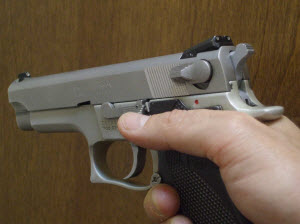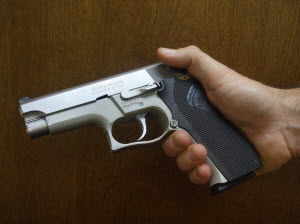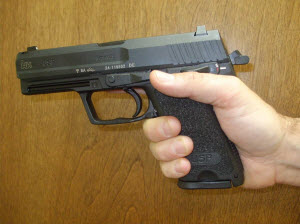Although recent trends in the law enforcement and commercial markets have favored striker-fired semi-automatic pistols for home and holster, the more traditional double-action semi-auto retains a strong presence.

Look closely: this Ruger P95 is out of battery due to the slide going forward with the decocking safety deployed.
www.personaldefensenetwork.com
Decocker-equipped pistols are found worldwide in police and security service. The current standard issue and substitute standard pistols of the U.S. armed forces are double-actions with decockers, and they have long been popular with civilian users as well. In training with such pistols, the realities imposed by the decocker must be recognized and accommodated.

With normal firing grip, shooter is unable to reach decocking safety.
www.personaldefensenetwork.comIn many cases, a pistol manufacturer will offer a variety of systems available on the same platform. For example, a Beretta model 96G (decock only) looks almost exactly like a model 96FS (decocking safety) and it takes more than a casual examination to note the huge difference between the two. This is also the case with the well-regarded Smith & Wesson third-generation family of pistols. The Ruger P-series guns use a different shaped lever to help distinguish the two systems more readily.

A much better option in this case may be to use the support hand to operate the decocker. As the support hand moves to join the firing hand in a proper two-handed grip, it can reach and deploy a slide-mounted device of virtually any design. The aforementioned Beretta and Smith & Wesson pistols work well this way because their levers rotate downward to decock, then must go back upward to the “FIRE” position.
Slide-mounted decocking safeties can pose another potential problem. For reliable function, every semi-automatic pistol slide needs to slam home with all the force that its recoil spring can provide. It is well established that anything that impairs this slide movement can cause a malfunction by not fully seating a round of ammunition in the chamber. If a slide-mounted decocking safety is deployed in the downward “SAFE” position before the slide is fully closed, it can impede the slide’s movement. This problem is most visible with inexperienced users to whom chambering a round with the “safety” turned off seems counterintuitive. Understanding the system and training to support it will help keep “out of battery” experiences to a minimum.

Frame-mounted decockers, such as those found on the classic SIG Sauer pistols or some Heckler & Koch models, can be easier to deploy because they tend to be located near the shooter’s thumb. It is, however, a function of the size and shape of the user’s hand that dictates if a firing grip can be maintained while using the decocking device. Once again, there can be an advantage to training the support hand to reach what the firing hand cannot.






The decocker are away of looking for trouble. They don’t work like they should. It’s fallty and you can hurt your self if it does fire. It’s a safety where if you pull the trigger nothing happen. It blocks the hammer locking pin for moving and keeps so when you move the tigger locking pin to the moves it out. And so when you pull the tigger nothing happens. That’s how it’s suppose to be done.
This is the perfect blog for everyone who hopes to find out about this topic. You know so much its almost hard to argue with you (not that I actually would want to
When was the de-cocking lever invented and by whom?
It truly is a classic nice and helpful piece of information and facts. I'm just content which you embraced this useful details around. Be sure to remain people up-to-date similar to this. Appreciate your discussing.
Sig Sauer P 226 X-Five Allround 9mm luger, is perfect for me, I'm a southpaw
Thanks for reading the article, Chris and Camsdaddy- I feel very strongly that you must understand the equipment and its features. The Dexx/Safety on your 3913 gives you an option of manual safety, if you want it. I too have always felt that the long D.A. trigger was safety enough to keep me out of trouble.
I have had a 3913tsw since the early 90's. This was my first handgun purchase and my only handgun for years. I always practices sweeping the lever up as I would draw. I have in the past few years disregarded the lever all together except to dexxxx once a round is loaded in the chamber. At that time I rotate the dexxxxer and carry the gun in that condition. I am quite comfortable relying on the DA trigger pull as a safety.
Very GOOD info, thanks
Thanks, MichaelH- I agree! Knowing how to use what you've got is better than wishing that it was something else.
Glad that this info was very friendly for the reader to understand, and without saying that unless you shoot a Glock your using the wrong firearm, great info which ever firearm you have shoot it, train with it, and Know how to deploy it when you need it. And that includes drawing the weapon and know shoot / dont shoot, thanks for all the great info and helping keep people educated.